12 Graphical Exploration of Data
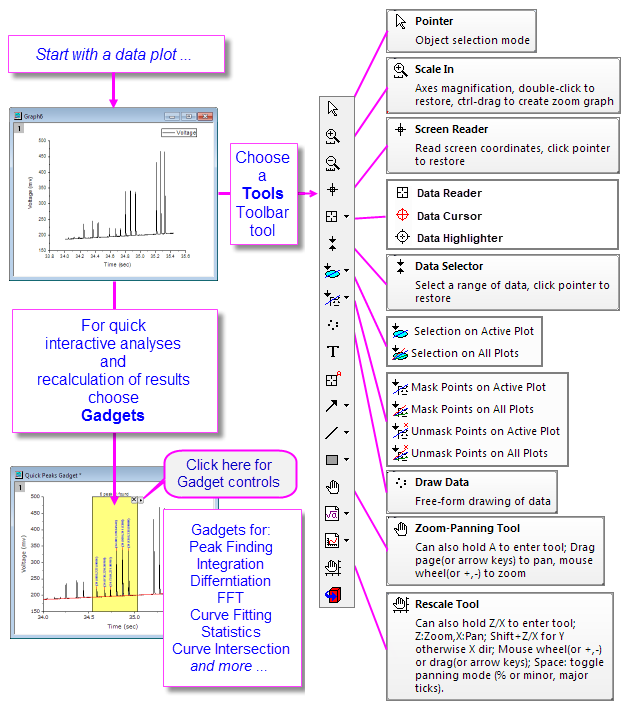
Origin includes a number of tools for graphically exploring your data including those for zooming and panning data plots, reading XY coordinate values and other data point metadata, or highlighting or masking selected data points.
 | With Origin 2016, OriginLab began releasing add-on tools called Apps. Many exploratory and analysis-related tools have been added to OriginLab's File Exchange since that time. If you find you need some exploratory or analysis tool that is not a standard part of Origin, you might check to see if the tool exists as an App. If it does not, request it!.
|
Plot Highlighting
While plot highlighting can be used to select a subset of data for more in-depth analysis, at a basic level it is useful for quick visual comparisons.

To engage plot highlighting:
- Click on one plot in the graph layer. Other plots in the layer and in linked layers sharing the same X axis, will be dimmed.
- Click on the plot in the Object Manager.
- To highlight/dim plots on hover (without clicking), click the Highlight Plot when Mouse Over Mini Toolbar button (page-level).

Other Origin features useful for quick visual inspection of data plots:
- If you have many columns of Y data, plotting a Browser Graph, or adding a Browser panel to an existing 2D line plot, can be useful for quick visual inspection. Clicking the menu on the Browser panel, you can plot every Nth column or Flip Through plots using a specified Move By factor.
- For scatter data, use the customizable Data Point Tooltip to read coordinate values and column metadata on mouseover.
- You can also use Tools toolbar buttons to zoom or pan your graph, as you will see in the next section.
- Origin has various other tools available for visually inspecting and recording information on your data plots and those are covered in the remaining subsections of this chapter.
Data Slicer
If you are plotting worksheet data where a data filter has been applied, you can enable a Data Slicer panel, make quick changes to filter conditions and see the effect on your plot. The tool is intended for plotting and comparing single categories.

- Apply one or more filters to your worksheet data and create your plot.
- Hover just inside the graph window but outside the layer and when you see the Mini Toolbar cursor, click and look for the Data Slicer button.
- Once the Data Slicer panel is enabled, you will want to right-click on the title bar of both the worksheet and the graph and Duplicate the two windows. Duplicating the two will allow you to make side-by-side comparisons.
- In the left panel of the duplicated graph, click on the listed filter(s) and choose another category from the drop-down list.
Zooming, Panning and Rescaling
Graphs, MagnifyingMagnifying Graphs
Graphs, ZoomingZooming Graphs
Graphs, PanningPanning Graphs
Graphs, RescalingRescaling Graphs
This section discusses the use of toolbar tools, and keyboard and menu commands that change the view of your 2D graph. We have split these tools and commands into two groups:
- Page-level zoom and pan operations that do not change axis scales.
- Axis rescale operations which zoom and pan the graph by changing axis From and To values.
Page-level Zoom and Pan
| Action
|
Button
|
Shortcut Key
|
Menu
|
Notes
|
| Zoom-Panning: Zoom and pan the graph page.
|

|
A +
+/- keys (zoom)
or
arrow keys (pan)
|
|
Click the toolbar button; or with the Pointer tool  active, place the cursor on the graph page and press "A", then ... active, place the cursor on the graph page and press "A", then ...
- Use +/- keys or mouse wheel to zoom in or out.
- Use the arrow keys to pan horizontally or vertically.
|
| Stepped Zoom-Pan†: Zoom graph in or out, by increment.
|


|
CTRL + I
CTRL + M
|
View:Zoom In and View:Zoom Out
|
- Stepped zoom.
- CTRL+I activates zoom in; click on the graph to establish the focal point.
- CTRL+M zooms out; clicking on graph not needed.
|
| Whole Page: Show the whole graph page.
|

|
CTRL + W
|
View: Whole Page
|
- Reset the view of the page after using the Zoom-Panning tools, above.
|
| Zoom All: All objects in the window are shown.
|
--
|
--
|
View: Zoom All
|
- Can be used to locate "lost" objects lying outside the graph page.
|
†Notes:These are older tools and methods that have been deprecated. Toolbar buttons are not shown by default. To add them to the workspace, use the Customize Toolbars dialog box (View: Toolbars > Graph button group).
Axis Rescaling
 | - If you do not see a toolbar button, it may be turned off. To add or remove buttons from a toolbar, see The Customize Toolbar Dialog Box.
- To prevent an axis from rescaling when using one of the axis rescaling tools, set Rescale = Fixed. If both X and Y axes are set to Fixed and you pick one of these axis rescaling tools, you are reminded that X and Y axes are in "Manual Rescale mode" and are prompted to proceed. Answering Yes will allow you to override and manually rescale in one or both dimensions. If you need to block such manual overrides of Fixed axis scales, set @nrm = 1.
|
Rotation of 3D openGL Graphs
 | This openGL toolbar that previously displayed when a 3D layer was selected, has been replaced by layer-level Mini Toolbar buttons.

|
When you click inside the layer of a 3D graph, the layer is selected and a Mini Toolbar appears. Click the Rotate Mode button to enter rotation mode; then use one of the hotkey/mouse combinations listed below; or drag the radial rotation handles in the graph with your mouse.
| Hot Key
|
Menu/Action
|
Context
|
| Rotate 3D graphs with the 3D floating buttons
|
| X + Arrow key
|
Rotate the 3D graph around the X axis.
|
With graph layer active and with Rotate Mode button selected in the 3D floating button group.

|
| Y + Arrow key
|
Rotate the 3D graph around the Y axis.
|
| Z + Arrow key
|
Rotate the 3D graph around the Z axis.
|
| Q + Arrow key
|
Rotate the 3D graph in screen.
|
| W + Arrow key
|
Rotate the 3D graph around any axes.
|
| Rotate 3D graphs using R key
|
| R + Mouse
|
Drag to rotate the 3D graph in an arbitrary direction.
|
Press "R" before pressing other keys.
Hovering on a 3D graph while pressing "R" changes the Pointer tool  to a to a  . Press Ctrl and/or Shift as needed, and rotate by (a) dragging with your mouse or (b) pressing the arrow keys on your keyboard. . Press Ctrl and/or Shift as needed, and rotate by (a) dragging with your mouse or (b) pressing the arrow keys on your keyboard.
|
| R + Ctrl + Mouse/Arrow key
|
Rotate the 3D graph around the X axis.
|
| R + Shift + Mouse/Arrow key
|
Rotate the 3D graph around the Y axis.
|
| R + Ctrl + Shift + Mouse/Arrow key
|
Rotate the 3D graph around the Z axis.
|
Reading Coordinate Values and Distances
Graphs, Reading Coordinate Values
Origin provides several tools to aid in labeling and graphical exploration of your data plots. Most of these tools are available from the Tools toolbar (View: Toolbars). There is a related tool -- Vertical Cursor -- available from the Gadgets menu.
Data Point Tooltip
Most 2D plot types, 3D Scatter, XYY Bar and XYZ Bar plots support a floating, customizable tooltip that reads data point values when you hover on a data point.
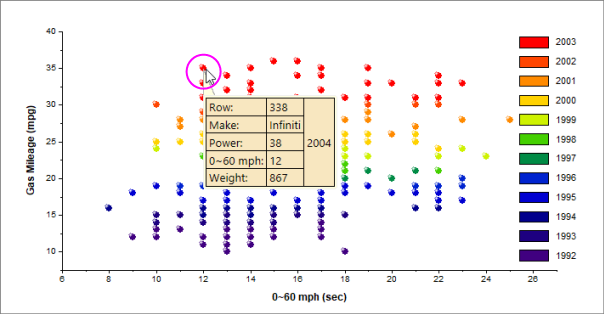
Tooltip Shortcut Menu
For tooltip customization and other options, right-click directly on the data point tooltip.
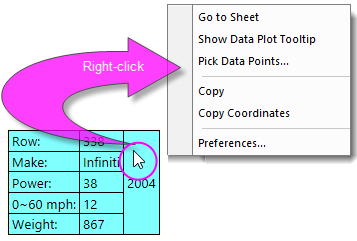
- Go to Sheet pops up the worksheet with source data highlighted.
- Show Data Plot Tooltip toggles display of a non-customizable data plot tooltip in place of the customizable data point tooltip (see, below).
- Pick Data Points puts the cursor into data reading mode and opens a Pick Points dialog. Double-click on points in the graph and when finished, click Done. This generates summary data (source, X-Y coordinates, etc.) for your picked points.
- Copy copies data point tooltip information, including labels, to the Clipboard.
- Copy Coordinates copies only coordinate values. Right-click on a cell and Paste each value to a separate cell within the row; or Paste (keep spaces) to paste values to the selected cell as a space-separated string.
- Preferences opens the Data Point Tooltip dialog allowing you to customize tooltip content and formatting. Use documentation of the Data Info window, below, as a guide to configuring your tooltips.
The Data Point Tooltip dialog is a slightly simpler version of the Data Info window's preferences dialog (Data Info Report Settings). See The Data Info Window for help with customizing your Data Point Tooltip.
 | By default, the Data Point Tooltip displays with a moderate degree of transparency. You can affect tooltip transparency by changing the value of LabTalk System Variable @TDT. For information on changing the value of a LabTalk System Variable, see this FAQ.
|
Data Plot Tooltip
There is a second tooltip that can be displayed in place of the Data Point Tooltip and this we refer to as the Data Plot Tootip. This non-customizable tooltip displays the source book, worksheet and coordinate datasets, on hover.

The Data Point Tooltip displays by default. If you prefer to use the Data Plot Tooltip, right-click on the Data Point Tooltip and choose to Show Data Plot Tooltip. Conversely, right-click on the Data Plot Tooltip and choose Show Data Point Tooltip.
Managing Tooltip Display
You can turn off display of data tooltips by activating the graph window, clicking on the View menu and clearing the check mark beside Data Tooltips.
There is a second way to control tooltip display that is more complicated but allows a greater degree of control. This entails changing the value of LabTalk system variables @PT and @PTI.
@PT=0; //Disable both data plot and data point tooltips
@PT=1; //Enable data plot tooltips for 2D graph
@PT=2; //Enable data plot tooltips for 3D OpenGL graph (default)
@PT=3; //Enable data plot tooltips for both 2D graph and 3D OpenGL graph
@PTI=0; //Disable only data point tooltips
@PTI=1; //Enable data point tooltips (default)
The Annotation Tool
Annotation Tool
The Annotation tool shares a "split-button" with the Distance Annotation and Angle Annotation tools.

Use the Annotation tool to label a data point. The tool works with Symbol/Line+Symbol and Column/Bar plots. Choose from several standard data point labels or create your own custom label using LabTalk script.
To annotate a data point:
- Click the Annotation button
 on the Tools toolbar and move the cursor to the desired data point. The cursor and the Status Bar will display the current label form. on the Tools toolbar and move the cursor to the desired data point. The cursor and the Status Bar will display the current label form.

- Use the TAB to toggle between the following standard annotation forms: (X coordinate value, Y coordinate value); (X coordinate value, Y coordinate value)[index number]; X coordinate value; Y coordinate value; index number (row number); or Custom (see Tutorial, next).
- When you've selected your label form, double-click to add a label to the data point; or single-click on the point and press Enter.

|
Tutorial: Customizing the Annotation String
The annotation string can be customized by combining literal characters with the X and Y coordinate values:
- Start with a graph of your data
- Open the Script Window (Window:Script Window) and type the following command, then press Enter:
system.annotation.customlabel$="X value: $(x,.2), Y value: $(y,*5)
- Click the Annotation button
 , hover on your graph, then press the Tab key several times to cycle through the annotation choices until the custom string format specified above is displayed in the Status Bar. The cursor will display the word "Custom". , hover on your graph, then press the Tab key several times to cycle through the annotation choices until the custom string format specified above is displayed in the Status Bar. The cursor will display the word "Custom".
- Start double-clicking on data points (or single-click and press Enter) to add the custom annotation string. The X values will be displayed with two decimal places and the Y values will be displayed with 5 significant digits, as specified by your script.
|
Adjustments using the Pointer Tool:
- To move a label to another data point, click the Pointer tool
 , press the ALT key and drag the label. , press the ALT key and drag the label.
- To re-position overlapping labels, drag the label. A leader line is automatically added.
- To copy a label to another data point, press CTRL + SHIFT and drag the label to a new data point.
| Note: Please view more information on string formatting in the Programming help file:
Help: Programming: LabTalk > Language Reference > Object Reference > Alphabetical Listing of Objects > String
|
The Screen Reader Tool
The Screen Reader  uses the Data Display window to report the XY(Z) coordinates of the cursor on the graph page. Note that the Screen Reader is not reading data point coordinates; rather it is reading page coordinates relative to the graph axes. uses the Data Display window to report the XY(Z) coordinates of the cursor on the graph page. Note that the Screen Reader is not reading data point coordinates; rather it is reading page coordinates relative to the graph axes.
The Data Display window opens automatically when you select the Screen Reader tool from the Tools toolbar (by default, the Data Display window is docked at the bottom of your Origin workspace).

You can alter basic properties of the Data Display window by right-clicking on the window title bar or by right-clicking inside the window.
To use the Screen Reader:
- Click the Screen Reader button
 on the Tools toolbar. This opens the Data Display tool. on the Tools toolbar. This opens the Data Display tool.
- Click on a location in the graph page to read its X,Y, and Z coordinates (ternary and contour only). Coordinate values show in the Data Display window.
- To increase cross-hair size, press the space bar.
- Click the Pointer button
 on the Tools toolbar to exit screen reading mode. on the Tools toolbar to exit screen reading mode.
The Data Reader Tool
The Data Reader  is used to read information associated with a data point in your plot. This could be coordinate values or it could be more complex information including metadata or even images that relate to the data point. The Data Reader works in concert with the customizable Data Info window. is used to read information associated with a data point in your plot. This could be coordinate values or it could be more complex information including metadata or even images that relate to the data point. The Data Reader works in concert with the customizable Data Info window.
The Data Reader tool is grouped with two related tools -- the Data Cursor  and the Data Highlighter and the Data Highlighter  . Only one of these toolbar buttons will show at any given time. To select a hidden tool, click on the small arrow to the right of the button and select a tool from the pop-up menu. . Only one of these toolbar buttons will show at any given time. To select a hidden tool, click on the small arrow to the right of the button and select a tool from the pop-up menu.
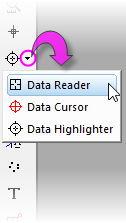
 | You can zoom into the graph while using the Data Reader. While the tool is active, press CTRL and use your mouse wheel to zoom in or out on the page.
|
- Click the Data Reader
 button on the Tools toolbar. This opens the Data Info window. button on the Tools toolbar. This opens the Data Info window.
- Click on a data point to read its X,Y (and Z, if they exist) coordinates. Coordinate values display in the Data Info window (and Data Display window).
- To move the cross-hair to the next data point along the data plot, use the LEFT and RIGHT arrow keys or click on the data point using your mouse. If you have multiple plots in a layer, use the UP and DOWN arrow keys to move to a data point on another plot or use your mouse to click on the point.
- To change the vertical and horizontal cross-hair size, click on a point and press the spacebar.
- Click the Pointer button
 on the Tools toolbar or Esc key to exit the Data Reader tool. on the Tools toolbar or Esc key to exit the Data Reader tool.
 | There are a number of system variables that control Arrow key acceleration and data-increment for the Data Reader. For more information, see the summary table in Reading Coordinate Values in the Graph.
|
The Data Cursor Tool
Data Cursor Tool
Graphs, Distance Between Two Points
The Data Cursor tool -- grouped on the Tools toolbar with the Data Reader tool -- allows you to place one or more cursors on a data plot and (using the Data Info window) read the cursor coordinates or measure the X and Y distance between two cursors, or the distance between a cursor and a point selected with the Data Reader.
Distance Annotation Tool
The Distance Annotation tool  shares a Tools toolbar "split-button" with the Annotation and Angle Annotation tools. shares a Tools toolbar "split-button" with the Annotation and Angle Annotation tools.

Use the Distance Annotation tool for drawing a scale-labeled, double-headed arrow between two points on a 2D graph.

- Click the Distance Annotation button
 on the Tools toolbars. on the Tools toolbars.
- On a graph, place the crosshair on the starting point and drag with your mouse. Press Shift to force the double-headed arrow to the horizontal or vertical
- To fine-tune arrow placement, right-click on the drawn arrow and choose Properties. Use Dimensions tab settings to control exact placement of object.
Angle Annotation Tool
The Angle Annotation tool  shares a Tools toolbar "split-button" with the Annotation and Distance Annotation tools. shares a Tools toolbar "split-button" with the Annotation and Distance Annotation tools.

Use the Angle Annotation tool to draw and label an interior angle of < 180°.
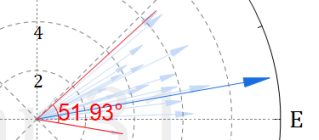
The Data Highlighter Tool
The Data Highlighter is grouped on the Tools toolbar with the Data Reader and Data Cursor tools. Use the Data Highlighter to pick one or more points in the your graph and simultaneously highlight the corresponding data row in the worksheet. Unselected points are dimmed in the graph and the worksheet.
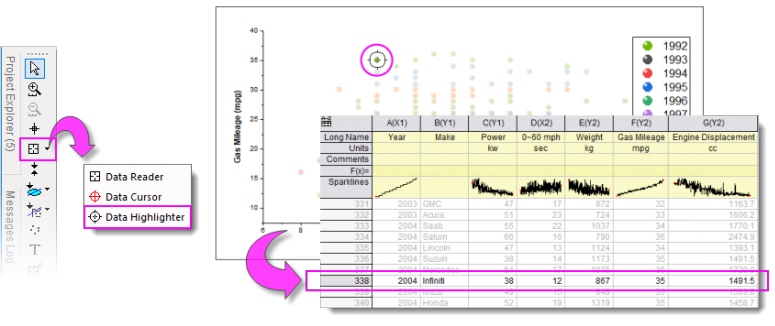
While in Data Highlighter mode ...
- CTRL+click to select multiple points in the graph.
- Drag out a rectangle/freehand object on the graph to select multiple points.
- Use SPACE to toggle between rectangle and freehand selection modes.
- Use left/right arrow keys to highlight individual points in sequence by row index.
- In the worksheet (still in Highlight mode), CTRL+click multiple rows or SHIFT+select blocks of rows, and highlight corresponding points in the graph.
- Press ESC to exit Highlight mode in the graph while keeping highlighted rows selected in the worksheet.
 | Some users did not know about ESC'ing (Highlight mode) in the graph window and found that when trying to plot selected data in the worksheet, the Plot Setup dialog opened. In this case, you can skip pressing the ESC key by setting system variable @QDHT=1. This will allow you to go directly to the worksheet and directly plot the highlighted data.
Another option, is to use the graph window's Create Subset Sheet Mini Toolbar button to output selected points to a new worksheet.

|
Collect Data from Multiple Sheets
When the Data Highlighter is active, a Mini Toolbar displays at the upper-right corner of the graph or worksheet window. The toolbar has buttons to Create Subset Sheet, Delete Points, Mask/Unmask Highlighted Points or Dimmed Points; plus a Highlighter Properties for configuring how to pick and collate data from multiple worksheets.
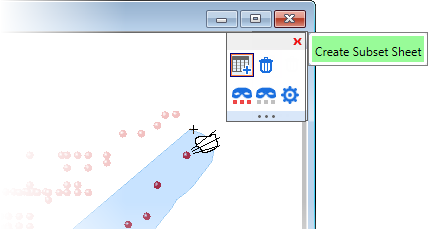
How to Pick Points Plotted from Multiple Sheets
Use this method for picking a subset of points from a graph window containing plots from multiple worksheets, and adding them to a single sheet:
- Pick the Data Highlighter tool
 , then CTRL+click to select multiple points from a SINGLE plot; or drag out a rectangle/freehand object on the graph to select multiple points (hint: press spacebar for ROI shape). , then CTRL+click to select multiple points from a SINGLE plot; or drag out a rectangle/freehand object on the graph to select multiple points (hint: press spacebar for ROI shape).
- When finished, click the Create Subset Sheet button
 on the Highlighter Mini Toolbar. on the Highlighter Mini Toolbar.
- Click the Open Properties Dialog button
 on the Mini Toolbar and set Add Data Mode = Append or Append with Gap. on the Mini Toolbar and set Add Data Mode = Append or Append with Gap.
- Continue to pick points from other plots (worksheets) as in step 1, clicking the Create Subset Sheet button each time you finish picking points from one of the plots.
- When you have finished, pick the Pointer tool
 . .
The Data Info Window
Graphical Exploration Tools, Data Info Window
Graphical Exploration Tools, Data Reader
Graphical Exploration Tools, Annotation
Graphical Exploration Tools, Data Cursor
Data Info Window
The Data Info window opens when you choose either the Data Reader  , the Annotation , the Annotation  or the Data Cursor tools or the Data Cursor tools  . When you click on a plotted data point with one of these tools, the Data Info window displays information about this particular data point. . When you click on a plotted data point with one of these tools, the Data Info window displays information about this particular data point.
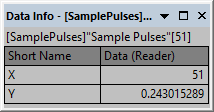
In its default configuration, the Data Info window reports only a column short name, plot designation (e.g. "X") and the XY coordinate values of a data point. However, the window is capable of displaying any of the worksheet-contained information that is associated with a data point including metadata and images.

To customize the Data Info window:
- Double-click on the Data Info window; or right-click and choose Preferences....
- Use the controls in the Data Info Report Settings dialog box to customize the display of the Data Info window:
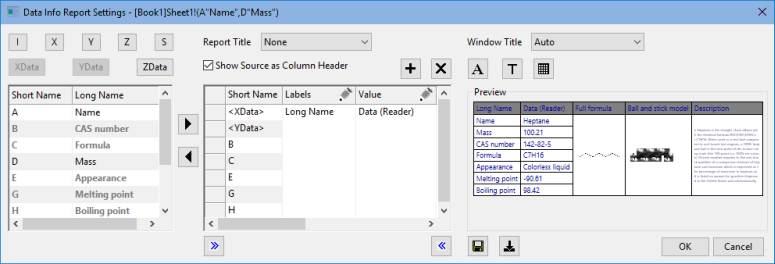
- The Data Info window can report any information in the source data worksheet. You are not limited to displaying plotted data.
- The window can display anything that can be inserted into the worksheet cell, including inserted graphs and images.
- The window can be customized with a Window Title and Report Title.
- Window configurations can be saved as Themes, including Save to <Graph>, Save to <Layer> and Save to <DataPlot>. This allows, for instance, all graph windows in your project or all graph layers in your multi-panel graph to have a unique Data Info window. Saved Themes can loaded and applied to the current Data Info window.
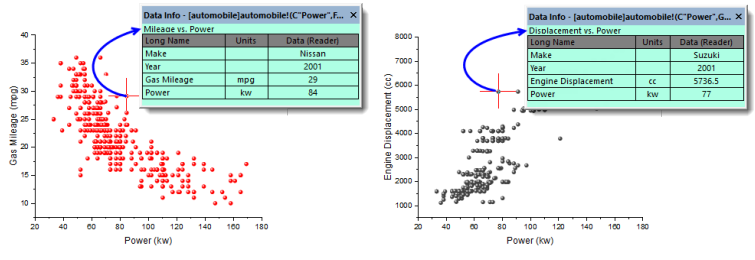
 | If you save your Data Info Theme settings in the graph, then save the graph window as a standalone graph window file (OGG, OGGU), know that the OGG/OGGU file travels only with the data that are plotted in the graph. Therefore, if your Data Info Theme uses data in other columns in your worksheet, the Data Info display will be incomplete if, for instance, you reopen the window file in a new project.
-
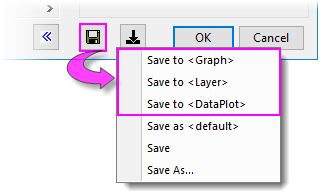
|
For more information on customizing the Data Info window, see:
Gadgets
Gadgets
Coordinates, Reading/Labeling
Statistics
Region of Interest (ROI)
Origin provides several Gadgets for data exploration and analysis. These gadgets are accessible from the Gadgets menu when a graph window is active. Three gadgets in particular are suitable for data exploration:
The Vertical Cursor gadget is especially useful for reading XY coordinate values for data points in stacked panel plots or multi-plot graphs, where plots share a common X scale.
To open the Vertical Cursor:
- With a graph window active, choose Gadgets: Vertical Cursor... from the main menu. This opens the Vertical Cursor dialog box.
Using the controls in this Gadget's dialog box, you can add data labels to the graph, increase or decrease label font size, hide labels, etc.
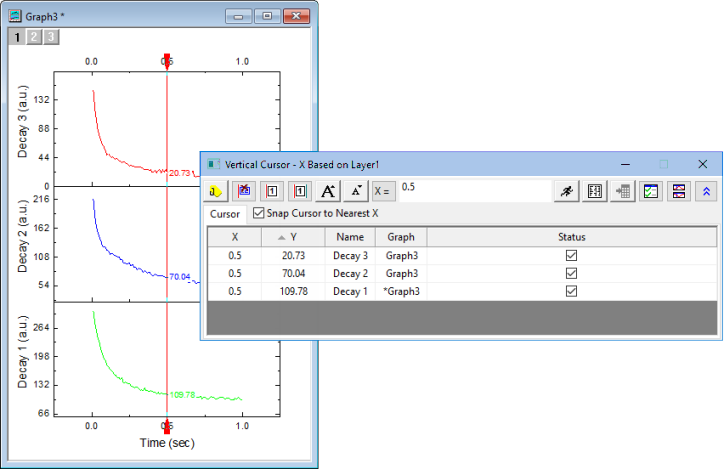
 | When labeling plots with the Vertical Cursor, you can opt to combine separate data labels into a single label by clicking the gadget's Show All Info in One Label button.
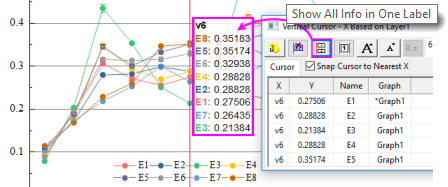
|
The Statistics gadget returns basic statistics on data points falling inside a rectangular region-of-interest (ROI) on the graph. Region of Interest (ROI)
- Display basic statistics for data inside the ROI.
- Display mean and nth Standard Deviation lines inside the ROI.
- Update results dynamically as ROI is moved or resized.
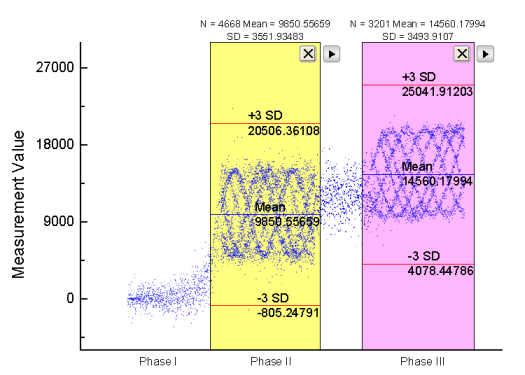
The Cluster gadget (available in OriginPro) provides the following features:
- Display basic statistics for data inside a region of interest (ROI).
- Switch between rectangular or elliptical ROI.
- View statistics for points inside and outside of the ROI.
- Edit, copy, mask, delete or group data points.
- Update results dynamically as ROI is moved/re-sized.
- Output results to a worksheet.
 | When you use the Cluster gadget to define a category (points within a ROI on a plot), you can apply a differentiating color to points within the ROI.
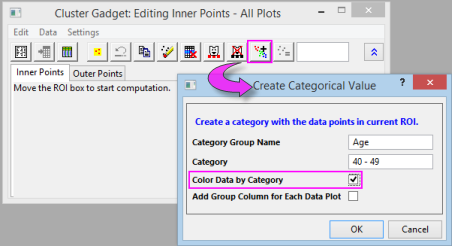
|
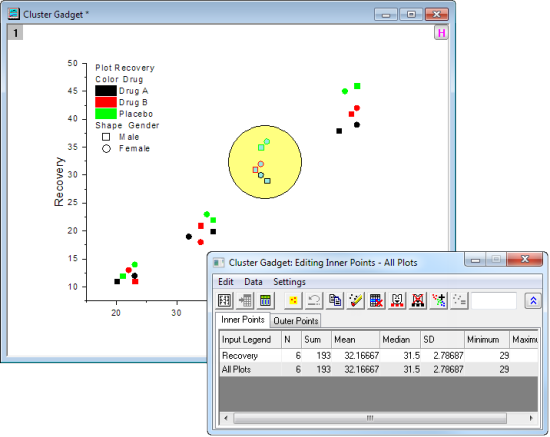
| Note: To learn more about these gadgets, see:
Help: Origin: Origin Help > Gadgets
|
Drawing Data Points on the Graph
This section discusses methods of graphically creating and modifying data plots.
This collection of tools and menu-driven operations is helpful in exploring certain "what if" scenarios, or to quickly generate some data for purposes such as testing a fitting function. These procedures work only with 2D scatter plots.
Drawing a Data Point
- Activate the graph window.
- Click on the Draw Data Tool
 . .
- A small dialog opens and displays the graph window short name. Click the Settings button to expand the options as below:
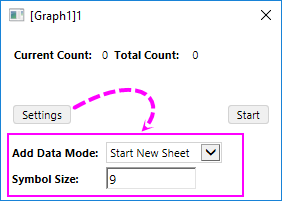
- Set Add Data Mode to Append With Gap. Click the Start button, then hover on the graph and double-click to set a data point. Continue clicking to set as many data points as you need.
- Points drawn on a new graph window will be added to a new sheet in the GAData book. Click the Worksheet button to pop-up this new Workbook.
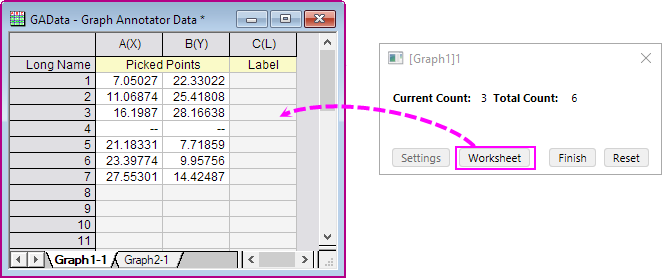
- Click Finish to end the point series.
- Each time you click Finish, a "--" separator is added to the worksheet columns to delineate a group of XY coordinates (drawn points).
- Points drawn on a new graph window will be added to a new sheet in the GAData book. Each graph window will have its own sheet in the workbook.
- To label data points, go to the new Worksheet and enter label information in the Label column. Note that Label column info can also be used to create plot groups by opening Plot Details and editing controls on the Symbol tab (e.g. Symbol Color is indexed, by points, using the Label column data).
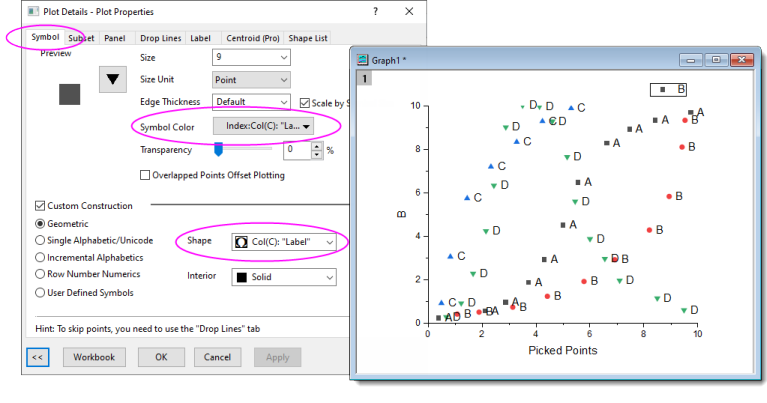
Moving or Deleting Data Points in the Graph
Data Points, Deleting
Data Points, Drawing
Moving a Data Point
Move data point in graph will change the underlying data in worksheet. For data imported with data connector, by default it's locked with the external data and therefore unmovable. You would need to click the data connector icon and unlock imported data, disconnect sheet, or fully remove data connector before moving data points in graph. Then do the following :
- Select Data: Move Data Points (you'll be warned that you are about to change your data). There are hints on status bar about how to move.
- Crosshair will be put to a point in graph. Use arrow keys to navigate to or directly click on point you want to move.
- Drag the point to new location or use Ctrl + arrow keys.
- Click the Pointer button
 on the Tools toolbar or press ESC to exit the Move Data Points mode. on the Tools toolbar or press ESC to exit the Move Data Points mode.
The data point is moved in the plot and the X and Y coordinates are changed in the worksheet cell.
 | By default, Move Data Points function caused scatter points to revert to the template's default style. You can press the TAB key to toggle between default symbol and customized symbol.
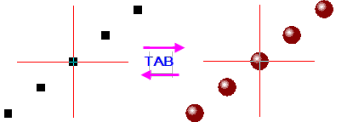
|
Deleting a Data Point
You can delete individual data points from your graph:
- Select Data: Remove Bad Data Points.
- Double-click on the data point, or click to select the data point and press ENTER key.
- Click Arrow button on Tools toolbar or press ESC key to exit the Remove Bad Data Points mode.
The data point is deleted from both the data plot and the worksheet cell. In the worksheet, only the data cell for the Y value will be cleared and shown as missing value.
Topics for Further Reading
|